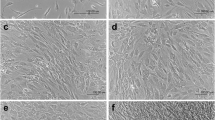Summary
We isolated osteoblastic cells derived from human periosteum and established them in culture. Their growth depended on the presence of ascorbic acid, and the doubling time was 40 to 60 h. The requirement for ascorbic acid was used to high production of collagen. These cells produced mainly type I collagen and only small amounts of type III collagen determined by reducing sodium dodecyl sulfate SDS-polyacrylamide gel electrophoresis. The total collagen yield was about 10 mg from 2×107 cells. The cells could be continuously cultured in α-minimum essential medium supplemented with 10% fetal bovine serum for 18 to 40 population doubling levels, depending on the age of the donated periosteum. These cells have the ability to calcify when incubated with 2 mM α-glycerophosphate-Na2. Calcification as viewed by the naked eye appeared from Day 15 after treatment. Treatment with the active formed vitamin D3, 1, 25 dihydroxyvitamin D3 enhanced calcification significantly and stimulated osteocalcin production. By electron microscopy, cells with many projections on their surfaces showed well-developed rough endoplasmic reticulum and actinlike fibers, and large numbers of lysosomes, mitochondria, and secretion granules. Many matrix vesicles, in which minerals were initially localized, and well-banded collagen fibrils were seen in the intercellular spaces. These observations demonstrate typical osteoblastic morphology. The above results indicate that cultured cells from human periostem are osteoblastic cells that have the capacity to differentiate into osteocytes and to deposit calcified minerals in response to 1,25 dihydroxyvitamin D3.
Similar content being viewed by others
References
Auf'mkolk, B. M.; Hauschka, P. V.; Schwartz, E. R. Characterization of human bone cells in culture. Calcif. Tissue Int. 37:228–235; 1985.
Brumbaugh, P. F.; Speer, D. P.; Pitt, M. J. Dihydroxyvitamin D3 a metabolite of vitamin D that promotes bone repair. Am. J. Pathol. 106:171–179; 1982.
Chen, P. S.; Tribara, T. Y.; Warner, H. Microdetermination of phosphorus. Anal. Chem. 28:1756–1758; 1956.
Gitelman, H. J. An improved automated procedure for the determination of calcium in biological specimens. Anal. Biochem. 18:520–531; 1967.
Mario, J. J.; de Carli, L. L. Phosphatase variants in a heteroploid strain of human cells in tissue culture. Nature 196:600–601; 1962.
Koshihara, Y.; Kawamura, M.; Oda, H., et al. In vitro calcification in human osteoblastic cell line derived from periosteum. Biochem. Biophys. Res. Commun. 145:651–657; 1987.
Price, P. A.; Baukol, S. A. 1,25-Dihydroxyvitamin D3 increase synthesis of the vitamin K-dependent bone protein by osteosarcoma cells. J. Biol. Chem. 255:11660–11663; 1980.
Raisz, L. G.; Trummel, C. L.; Helick, M. F., et al. 1,25-Dihydroxycholecalciferol: a potent stimulator of bone resorption in tissue culture. Science 175:768–769; 1972.
Sudo, M.; Kodama, H.; Amagai, Y., et al. In vitro differentiation and calcification in a new clonal osteogenic cell line derived from newborn mouse calvaria. J. Cell Biol. 96:191–198; 1983.
Sykes, B.; Puddle, B.; Fracis, M., et al. The estimation of two collagens from human dermis by interrupted gel electrophoresis. 72:1472–1480; 1976.
Tsutumi, C.; Hosoya, N.; Noriuchi, S. The changes of bone carboxyglutamic acid-containing protein in bone and serum of developing chick. J. Nutr. Sci. Vitaminol. 29:643–654; 1983.
Vogel, J. J. Mineralization of bones and teeth. In: E. P. Lazari, ed. Dental biochemistry, 2nd ed. Philadelphia: Lea & Febinger; 1976:99–111.
Webber, R. J.; Harris, M. G.; Hough, A. J. Cell culture of rabbit meniscal fibrochondrocytes proliferative and synthetic response to growth factors and ascorbate. J. Orthop. Res. 3:36–42; 1985.
Author information
Authors and Affiliations
Rights and permissions
About this article
Cite this article
Koshihara, Y., Kawamura, M., Endo, S. et al. Establishment of human osteoblastic cells derived from periosteum in culture. In Vitro Cell Dev Biol 25, 37–43 (1989). https://doi.org/10.1007/BF02624408
Received:
Accepted:
Issue Date:
DOI: https://doi.org/10.1007/BF02624408




